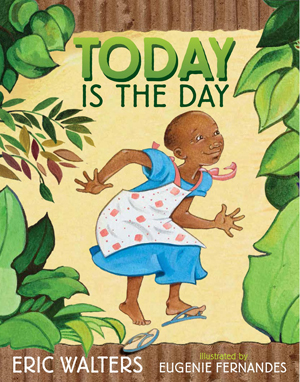| ________________
CM . . .
. Volume XXII Number 12. . . .November 20, 2015
excerpt:
Today is the Day is the third book of Canadian award winning author and activist Eric Walters that is based on a true story involving orphans who reside at the Rolling Hill Residence in the Mbooni district in Kenya. Today is the Day focuses on a special and unique birthday celebration at an African orphanage. From the moment she woke up, Mutanu was bursting with excitement for the day had arrived. This was the first time she would experience this special celebration. But chores came first, and she had to sweep the yard and feed the orphanage dog, Rafiki. Among the relatives who arrived at the orphanage was Mutanu's grandmother, now too old and frail to care for her granddaughter. Then the event began. Each name of the 115 children was called. As they come forward, they received a colourful hat and a cloth bag filled with toys, shirts, pencils, notebooks, candy and toothbrushes, jump ropes and notebooks. Afterwards, the children gathered around a large table that held 15 decorated cakes. Matron announced that for those children who did not know the date of their birth, that that day, July the twelfth, would officially be their birthday. And then the moment Mutanu had been waiting for happened, the singing of Happy Birthday! Today was Mutanu's day her birthday. Throughout the story, Mutanu frequently mentions the birth dates of the animals at the orphanage. The significance of this becomes evident during the celebration. She was not forgotten. Her birth was now acknowledged and joyously celebrated. Eric Walter's expressive text has a natural flow, and the dialogue readily connects the reader to characters. Illustrator Eugenie Fernandes provides the young audience with large, brightly coloured pictures that capture the emotions of the characters. The blending of the simplicity of the drawings with the details of daily life at the orphanage enhances the text The section at the end of the book, Happy Birthday to Me, connects the young audience with the background behind the story. It explains the reason why many of the children born in Kenya are orphans, why they do not know their birth date, and why many orphans are seen as having little value. The accompanying photographs of the real story, including photographs of the key character Mutanu and the birthday celebration, link a visual to the written word, thereby making the story come alive for the readers. Through Eric Walter's initiative, the Creation of Hope, the staff at the orphanage ensures that each child receives a government issued birth certificate to "acknowledge them as real people with all the rights of citizens". Highly Recommended. Janice Foster is a retired teacher and teacher-librarian in Winnipeg. MB.
To comment
on this title or this review, send mail to cm@umanitoba.ca.
Copyright © the Manitoba Library Association. Reproduction for personal
use is permitted only if this copyright notice is maintained. Any
other reproduction is prohibited without permission.
Next Review |
Table of Contents for This Issue
- November 20, 2015. |
